unit 1 Time
EIM Book 1 Unit 1 Free time 单元知识要点

Unit 1 Free TimePart 1 (p11-12)New Wordunusual [ʌnˈju: ʒuəl] adj. 特别的,不寻常的while [waɪl] n. 一段时间,一会儿bee [bi:] n. 蜜蜂kilo [ˈki: ləʊ] n. 千克,公斤beekeeping [ˈbi: ki: pɪŋ] n. 养蜂produce [prəˈdju: s] v. 生产beehive [ˈbi: haɪv] n. 蜂窝,蜂巢sell [sel] v. 卖(sold-sold)typical [ˈtɪpɪkl] adj. 典型,传统的near [nɪə(r)] adv. 靠近,附近feed [fi: d] v. 喂养keep[ki: p] v. 保持,保存photograph [ˈfəʊtəɡrɑ: f] n. 照片volleyball [ˈvɒlibɔ: l] n. 排球Word Formual adj. ---unusual adj. ---usually adv. ---unusually adv.2.produce [prəˈdju: s] v. 生产---product n. 产品3.sell [sel] v. 卖(sold-sold) ---sale [seɪl] n. 销售4.scared [skeəd] adj. 害怕,恐惧---scary [ˈskeəri] adj. 恐怖的,吓人的---scare [skeə(r)] v. 惊吓,使害怕Phrases and Sentences1.like doing.../love doing... /enjoy doing... 喜欢做...2.feed... with... 用...喂养...Claire feeds the bees with sugar and water.feed on 以...为食e round 拜访(visit)My close friend came round last weekend, and we had fun together.4.go near 靠近The little boy goes near the cage and feeds the rabbit with carrots.5.be scared of sth. 害怕某物6.for a while 一会儿7.take photos of 给...照相8. a kilo of honey 一千克蜂蜜two kilos of honey 两千克蜂蜜9.take ...to... 把...带去... (bring...to... 把...带来)10.keep sb./sth. adj. 保持某人/某事怎么样keep doing... 一直做某事beekeeping =keeping bees 养蜂magician [məˈdʒɪʃn] n. 魔术师trick [trɪk] n. 戏法,把戏,骗局,恶作剧hate [heɪt] v. 憎恨;n. 仇视,痛恨work [wɜ: k] v. 奏效,发挥作用,运转paint [peɪnt] n. 油漆,涂料;v. 油漆,绘画,用颜料画interest [ˈɪntrəst] n. 兴趣diary [ˈdaɪəri] n. 日记To be understood:bird-watching n. 观/赏鸟puzzle [ˈpʌzl] n. 谜Word Form1.magic [ˈmædʒɪk] adj. 魔法的,魔力的,极好的;n. 魔法,巫术,魔力---magician n. 魔术师2.interest n. 兴趣;v. 使感兴趣---interesting adj. 有趣的---interested adj. 感兴趣的3.paint v./n. ---painter n. 画家---painting n. 画作Phrases and Sentences1.be interested in (doing) sth.=take/have (an) interest in (doing) sth. 对做某事感兴趣,有兴趣做某事2.hate to do sth. 讨厌做某事(后接to do通常表示一个具体或一次性和特指的动作)hate doing sth. 讨厌做某事(后接doing通常表示习惯性或经常性和不具体的动作)I hate to do this to you.I hate doing the dishes. It’s so boring.3.play a trick on sb. 对某人做恶作剧,捉弄某人He played a trick on me yesterday, so I was angry.4.It takes sb. some time to do sth.It tkaes me an hour to go to school.5.work v.He only wnats to know how the tricks works.My alarm clock didn’t work this morning, so I was late for school.6.keep a diary 写日记7.go for walks=go for a walk 去散步8.make models 制作模型9.do puzzles 玩拼图10.collect stickers/coins 收藏帖子/硬币11.hang out with friends 和朋友出去玩club[klʌb] n. 俱乐部,社团physics [ˈfɪzɪks] n. 物理学north-west [ˌnɔ:θˈwest] n. 西北creative [kriˈeɪtɪv] adj. 创新的,有创造力的maths[mæθs] n. 数学(=mathematics) drama [ˈdrɑ: mə] n. 戏剧,戏剧文学history[ˈhɪstri] n. 历史(学) extra [ˈekstrə] adj. 额外的,补充的geography [dʒiˈɒɡrəfi] n. 地理(学) lunchtime [ˈlʌntʃtaɪm] n. 午餐时间,午休时间information [ˌɪnfəˈmeɪʃn] un. 信息activity [ækˈtɪvəti] n. 活动(activities) communication [kəˌmju: nɪˈkeɪʃn] n. 交流,通讯artistic [ɑ: ˈtɪstɪk] adj. 艺术的technology[tekˈnɒlədʒi] n. 科技organise ['ɔ:gənaɪz] v. 组织science[ˈsaɪəns] n. 科学,理科agree [əˈɡri:] v. 同意biology [baɪˈɒlədʒi] n. 生物(学) develop [dɪˈveləp] v. 发展,形成chemistry[ˈkemɪstri] n. 化学photography [fəˈtɒɡrəfi] n. 摄影To be understood:1.national curriculum n. (英国5~16岁的)全国统一课程2.PE(physical education) n. 体育3.extra-curricular [ˌekstrə kəˈrɪkjələ(r)] adj. 课外的4.theatre [ˈθɪətə(r)] n. 戏院,喜剧工作,演戏5.pottery [ˈpɒtəri] n. 陶器6.orchestra [ˈɔ: kɪstrə] n. 管弦乐队7.trombone [trɒmˈbəʊn] n. 长号8.imagine [ɪˈmædʒɪn] v. 想象,设想Word Formmunicate [kəˈmju: nɪkeɪt] v. 表达,交流---communication2.art [ɑ: t] n. 艺术---artist [ˈɑ: tɪst] n. 艺术家---artistic [ɑ: ˈtɪstɪk] adj. 艺术的3.create [kriˈeɪt] v. 创造,创作---creative [kriˈeɪtɪv] adj. 创新的,有创造力的4.agree [əˈɡri:] v. 同意---disagree [ˌdɪsəˈɡri:] v. 不同意5.photo[ˈfəʊtəʊ] ---photograph [ˈfəʊtəɡrɑ: f] n. 照片;v. 拍照---photography [fəˈtɒɡrəfi] n. 摄影---photographer [fəˈtɒɡrəfə(r)] n. 摄影师6.choose [tʃu: z] v. 选择---choice [tʃɔɪs] n. 选择Phrases and Sentences1.join the...club 加入...社团2.in the north-west of 在...西北in the north-east of 在...东北in the south-west of 在...西南in the south-east of 在...东南Chengdu is in the south-west of China.3.all-girls school 女子学校rmation 不可数a piece of information 一则消息information about... 关于...的信息5.choose from... 从...里选择There are many restaurants, you can choose one from them.6.all kinds of 各种各样的7.get help from sb. 得到某人的帮助8.hope to do sth. 希望做某事I hope to spend my holiday in Hawaii.hope that...I hope that you can get a good result in the exam.注意:不能说hope sb. to do sth.9.take photographs(photos) 拍照10.agree with sb. 同意(赞成)某人的意见agree about/on sth. 就某一事取得一致意见I agree with them about the rules in our class.agree to do sth. 同意做某事They all agree to have a break after lunch.agree that...I agree that he is a good manager.。
新视野大学英语第二版Unit1-7原文+课后翻译
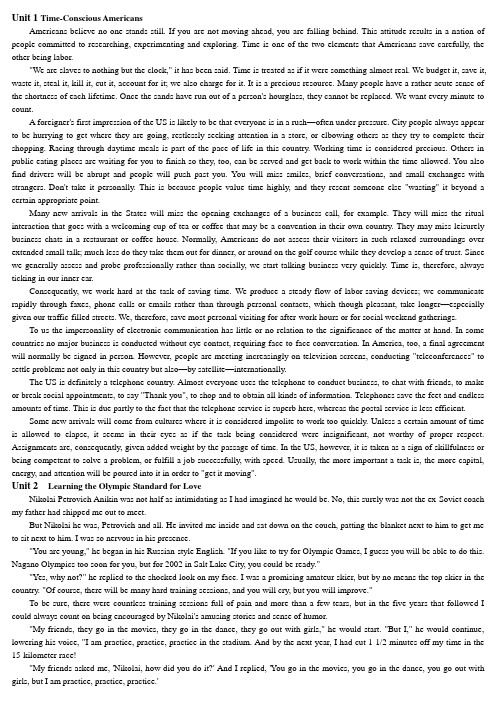
Unit 1 Time-Conscious AmericansAmericans believe no one stands still. If you are not moving ahead, you are falling behind. This attitude results in a nation of people committed to researching, experimenting and exploring. Time is one of the two elements that Americans save carefully, the other being labor."We are slaves to nothing but the clock," it has been said. Time is treated as if it were something almost real. We budget it, save it, waste it, steal it, kill it, cut it, account for it; we also charge for it. It is a precious resource. Many people have a rather acute sense of the shortness of each lifetime. Once the sands have run out of a person's hourglass, they cannot be replaced. We want every minute to count.A foreigner's first impression of the US is likely to be that everyone is in a rush—often under pressure. City people always appear to be hurrying to get where they are going, restlessly seeking attention in a store, or elbowing others as they try to complete their shopping. Racing through daytime meals is part of the pace of life in this country. Working time is considered precious. Others in public eating-places are waiting for you to finish so they, too, can be served and get back to work within the time allowed. You also find drivers will be abrupt and people will push past you. You will miss smiles, brief conversations, and small exchanges with strangers. Don't take it personally. This is because people value time highly, and they resent someone else "wasting" it beyond a certain appropriate point.Many new arrivals in the States will miss the opening exchanges of a business call, for example. They will miss the ritual interaction that goes with a welcoming cup of tea or coffee that may be a convention in their own country. They may miss leisurely business chats in a restaurant or coffee house. Normally, Americans do not assess their visitors in such relaxed surroundings over extended small talk; much less do they take them out for dinner, or around on the golf course while they develop a sense of trust. Since we generally assess and probe professionally rather than socially, we start talking business very quickly. Time is, therefore, always ticking in our inner ear.Consequently, we work hard at the task of saving time. We produce a steady flow of labor-saving devices; we communicate rapidly through faxes, phone calls or emails rather than through personal contacts, which though pleasant, take longer—especially given our traffic-filled streets. We, therefore, save most personal visiting for after-work hours or for social weekend gatherings.To us the impersonality of electronic communication has little or no relation to the significance of the matter at hand. In some countries no major business is conducted without eye contact, requiring face-to-face conversation. In America, too, a final agreement will normally be signed in person. However, people are meeting increasingly on television screens, conducting "teleconferences" to settle problems not only in this country but also—by satellite—internationally.The US is definitely a telephone country. Almost everyone uses the telephone to conduct business, to chat with friends, to make or break social appointments, to say "Thank you", to shop and to obtain all kinds of information. Telephones save the feet and endless amounts of time. This is due partly to the fact that the telephone service is superb here, whereas the postal service is less efficient.Some new arrivals will come from cultures where it is considered impolite to work too quickly. Unless a certain amount of time is allowed to elapse, it seems in their eyes as if the task being considered were insignificant, not worthy of proper respect. Assignments are, consequently, given added weight by the passage of time. In the US, however, it is taken as a sign of skillfulness or being competent to solve a problem, or fulfill a job successfully, with speed. Usually, the more important a task is, the more capital, energy, and attention will be poured into it in order to "get it moving".Unit 2 Learning the Olympic Standard for LoveNikolai Petrovich Anikin was not half as intimidating as I had imagined he would be. No, this surely was not the ex-Soviet coach my father had shipped me out to meet.But Nikolai he was, Petrovich and all. He invited me inside and sat down on the couch, patting the blanket next to him to get me to sit next to him. I was so nervous in his presence."You are young," he began in his Russian-style English. "If you like to try for Olympic Games, I guess you will be able to do this. Nagano Olympics too soon for you, but for 2002 in Salt Lake City, you could be ready.""Yes, why not?" he replied to the shocked look on my face. I was a promising amateur skier, but by no means the top skier in the country. "Of course, there will be many hard training sessions, and you will cry, but you will improve."To be sure, there were countless training sessions full of pain and more than a few tears, but in the five years that followed I could always count on being encouraged by Nikolai's amusing stories and sense of humor."My friends, they go in the movies, they go in the dance, they go out with girls," he would start. "But I," he would continue, lowering his voice, "I am practice, practice, practice in the stadium. And by the next year, I had cut 1-1/2 minutes off my time in the 15-kilometer race!"My friends asked me, 'Nikolai, how did you do it?' And I replied, 'You go in the movies, you go in the dance, you go out with girls, but I am practice, practice, practice.'Here the story usually ended, but on one occasion, which we later learned was his 25th wedding anniversary, he stood proudly in a worn woolen sweater and smiled and whispered, "And I tell you, I am 26 years old before I ever kiss a girl! She was the woman I later marry."Romantic and otherwise, Nikolai knew love. His consistent good humor, quiet gratitude, perceptivity, and sincerity set an Olympic standard for love that I continue to reach for, even though my skiing days are over.Still, he never babied me. One February day I had a massive headache and felt quite fatigued. I came upon him in a clearing, and after approximately 15 minutes of striding into the cold breeze over the white powder to catch him, I fussed, "Oh, Nikolai, I feel like I am going to die.""When you are a hundred years old, everybody dies," he said, indifferent to my pain. "But now," he continued firmly. "Now must be ski, ski, ski."And, on skis, I did what he said. On other matters, though, I was rebellious. Once, he packed 10 of us into a Finnish bachelor's tiny home for a low-budget ski camp. We awoke the first morning to find Nikolai making breakfast and then made quick work with our spoons while sitting on makeshift chairs around a tiny card table. When we were finished, Nikolai stacked the sticky bowls in front of my sole female teammate and me, asserting, "Now, girls do dishes!"I threw my napkin on the floor and swore at him, "Ask the damn boys! This is unfair." He never asked this of me again, nor did he take much notice of my outburst. He saved his passion for skiing.When coaching, he would sing out his instructions keeping rhythm with our stride: "Yes, yes, one-two-three, one-two-three." A dear lady friend of my grandfather, after viewing a copy of a video of me training with Nikolai, asked, "Does he also teach dance?"In training, I worked without rest to correct mistakes that Nikolai pointed out and I asked after each pass if it was better."Yes, it's OK. But the faster knee down, the better.""But is it fast enough?" I'd persist.Finally he would frown and say, "Billion times you make motion—then be perfect," reminding me in an I've-told-you-a-billion-times tone, "You must be patient."Nikolai's patience and my hard work earned me a fourth-place national ranking heading into the pre-Olympic season, but then I missed the cut for the 2002 Olympics.Last summer, I returned to visit Nikolai. He made me tea... and did the dishes! We talked while sitting on his couch. Missing the Olympic Team the previous year had made me pause and reflect on what I had gained—not the least of which was a quiet, indissoluble bond with a short man in a tropical shirt.Nikolai taught me to have the courage, heart, and discipline to persist, even if it takes a billion tries. He taught me to be thankful in advance for a century of life on earth, and to remind myself every day that despite the challenges at hand, "Now must be love, love, love."Unit3Marriage Across the NationsGail and I imagined a quiet wedding. During our two years together we had experienced the usual ups and downs of a couple learning to know, understand, and respect each other. But through it all we had honestly confronted the weaknesses and strengths of each other's characters.Our racial and cultural differences enhanced our relationship and taught us a great deal about tolerance, compromise, and being open with each other. Gail sometimes wondered why I and other blacks were so involved with the racial issue, and I was surprised that she seemed to forget the subtler forms of racial hatred in American society.Gail and I had no illusions about what the future held for us as a married, mixed couple in America. The continual source of our strength was our mutual trust and respect.We wanted to avoid the mistake made by many couples of marrying for the wrong reasons, and only finding out ten, twenty, or thirty years later that they were incompatible, that they hardly took the time to know each other, that they overlooked serious personality conflicts in the expectation that marriage was an automatic way to make everything work out right. That point was emphasized by the fact that Gail's parents, after thirty-five years of marriage, were going through a bitter and painful divorce, which had destroyed Gail and for a time had a negative effect on our budding relationship.When Gail spread the news of our wedding plans to her family she met with some resistance. Her mother, Deborah, all along had been supportive of our relationship, and even joked about when we were going to get married so she could have grandchildren. Instead of congratulations upon hearing our news, Deborah counseled Gail to be really sure she was doing the right thing."So it was all right for me to date him, but it's wrong for me to marry him. Is his color the problem, Mom?" Gail subsequently told me she had asked her mother."To start with I must admit that at first I harbored reservations about a mixed marriage, prejudices you might even call them. But when I met Mark I found him a charming and intelligent young guy. Any mother would be proud to have him for a son-in-law. So,color has nothing to do with it. Yes, my friends talk. Some even express shock at what you're doing. But they live in a different world. So you see, Mark's color is not the problem. My biggest worry is that you may be marrying Mark for the same wrong reasons that I married your father. When we met I saw him as my beloved, intelligent, charming, and caring. It was all so new, all so exciting, and we both thought, on the surface at least, that ours was an ideal marriage with every indication that it would last forever. I realized only later that I didn't know my beloved, your father, very well when we married.""But Mark and I have been together more than two years," Gail railed. "We've been through so much together. We've seen each other at our worst many times. I'm sure that time will only confirm what we feel deeply about each other.""You may be right. But I still think that waiting won't hurt. You're only twenty-five."Gail's father, David, whom I had not yet met personally, approached our decision with a father-knows-best attitude. He basically asked the same questions as Gail's mother: "Why the haste? Who is this Mark? What's his citizenship status?" And when he learned of my problems with the Citizenship department, he immediately suspected that I was marrying his daughter in order to remain in the United States."But Dad, that's harsh," Gail said."Then why the rush? Buy time, buy time," he remarked repeatedly."Mark has had problems with citizenship before and has always taken care of them himself," Gail defended." In fact, he made it very clear when we were discussing marriage that if I had any doubts about anything, I should not hesitate to cancel our plans."Her father proceeded to quote statistics showing that mixed couples had higher divorce rates than couples of the same race and gave examples of mixed couples he had counseled who were having marital difficulties."Have you thought about the hardships your children would go through?" he asked."Dad, are you a racist?""No, of course not. But you have to be realistic.""Maybe our children will have some problems, but whose children don't? But one thing they'll always have: our love and devotion.""That's idealistic. People can be very cruel toward children from mixed marriages.""Dad, we'll worry about that when the time comes. If we had to resolve all doubt before we acted, very little would ever get done.""Remember, it's never too late to change your mind."Unit 4 A Test of True LoveSix minutes to six, said the digital clock over the information desk in Grand Central Station. John Blandford, a tall young army officer, focused his eyesight on the clock to note the exact time. In six minutes he would see the woman who had filled a special place in his life for the past thirteen months, a woman he had never seen, yet whose written words had been with him and had given him strength without fail.Soon after he volunteered for military service, he had received a book from this woman. A letter, which wished him courage and safety, came with the book. He discovered that many of his friends, also in the army, had received the identical book from the woman, Hollis Meynell. And while they all got strength from it, and appreciated her support of their cause, John Blandford was the only person to write Ms. Meynell back. On the day of his departure, to a destination overseas where he would fight in the war, he received her reply. Aboard the cargo ship that was taking him into enemy territory, he stood on the deck and read her letter to him again and again.For thirteen months, she had faithfully written to him. When his letters did not arrive, she wrote anyway, without decrease. During the difficult days of war, her letters nourished him and gave him courage. As long as he received letters from her, he felt as though he could survive. After a short time, he believed he loved her, and she loved him. It was as if fate had brought them together.But when he asked her for a photo, she declined his request. She explained her objection: "If your feelings for me have any reality, any honest basis, what I look like won't matter. Suppose I'm beautiful. I'd always be bothered by the feeling that you loved me for my beauty, and that kind of love would disgust me. Suppose I'm plain. Then I'd always fear you were writing to me only because you were lonely and had no one else. Either way, I would forbid myself from loving you. When you come to New York and you see me, then you can make your decision. Remember, both of us are free to stop or to go on after that—if that's what we choose..."One minute to six... Blandford's heart leaped.A young woman was coming toward him, and he felt a connection with her right away. Her figure was long and thin, her spectacular golden hair lay back in curls from her small ears. Her eyes were blue flowers; her lips had a gentle firmness. In her fancy green suit she was like springtime come alive.He started toward her, entirely forgetting to notice that she wasn't wearing a rose, and as he moved, a small, warm smile formed on her lips."Going my way, soldier?" she asked.Uncontrollably, he made one step closer to her. Then he saw Hollis Meynell.She was standing almost directly behind the girl, a woman well past forty, and a fossil to his young eyes, her hair sporting patches of gray. She was more than fat; her thick legs shook as they moved. But she wore a red rose on her brown coat.The girl in the green suit was walking quickly away and soon vanished into the fog. Blandford felt as though his heart was being compressed into a small cement ball, so strong was his desire to follow the girl, yet so deep was his longing for the woman whose spirit had truly companioned and brought warmth to his own; and there she stood. Her pale, fat face was gentle and intelligent; he could see that now. Her gray eyes had a warm, kindly look.Blandford resisted the urge to follow the younger woman, though it was not easy to do so. His fingers held the book she had sent to him before he went off to the war, which was to identify him to Hollis Meynell. This would not be love. However, it would be something precious, something perhaps even less common than love—a friendship for which he had been, and would always be, thankful.He held the book out toward the woman."I'm John Blandford, and you—you are Ms. Meynell. I'm so glad you could meet me. May I take you to dinner?" The woman smiled. "I don't know what this is all about, son," she answered. "That young lady in the green suit—the one who just went by—begged me to wear this rose on my coat. And she said that if you asked me to go out with you, I should tell you that she's waiting for you in that big restaurant near the highway. She said it was some kind of a test."Unit5 Weeping for My Smoking DaughterMy daughter smokes. While she is doing her homework, her feet on the bench in front of her and her calculator clicking out answ ers to her geometry problems, I am looking at the half-empty package of Camels tossed carelessly close at hand. I pick them up, take t hem into the kitchen, where the light is better, and study them -- they are filtered, for which I am grateful. My heart feels terrible. I wa nt to weep. In fact, I do weep a little, standing there by the stove holding one of the instruments, so white, so precisely rolled, that coul d cause my daughter's death. When she smoked Marlboros and Players I hardened myself against feeling so bad; nobody I knew ever s moked these brands.She doesn't know this, but it was Camels that my father, her grandfather, smoked. But before he smoked cigarettes made by manu facturers -- when he was very young and very poor, with glowing eyes -- he smoked Prince Albert tobacco in cigarettes he rolled hims elf. I remember the bright-red tobacco tin, with a picture of Queen Victoria's partner, Prince Albert, dressed in a black dress coat and c arrying a cane .By the late forties and early fifties no one rolled his own anymore (and few women smoked) in my hometown of Eatonton, Georg ia. The tobacco industry, coupled with Hollywood movies in which both male and female heroes smoked like chimneys, completely w on over people like my father, who were hopelessly hooked by cigarettes. He never looked as fashionable as Prince Albert, though; he continued to look like a poor, overweight, hard working colored man with too large a family, black, with a very white cigarette stuck i n his mouth.I do not remember when he started to cough. Perhaps it was unnoticeable at first, a little coughing in the morning as he lit his first cigarette upon getting out of bed. By the time I was sixteen, my daughter's age, his breath was a wheeze, embarrassing to hear; he cou ld not climb stairs without resting every third or fourth step. It was not unusual for him to cough for an hour.My father died from "the poor man's friend", pneumonia, one hard winter when his lung illnesses had left him low. I doubt he had much lung left at all, after coughing for so many years. He had so little breath that, during his last years, he was always leaning on som ething. I remembered once, at a family reunion, when my daughter was two, that my father picked her up for a minute -- long enough for me to photograph them -- but the effort was obvious. Near the very end of his life, and largely because he had no more lungs, he qu it smoking. He gained a couple of pounds, but by then he was so slim that no one noticed.When I travel to Third World countries I see many people like my father and daughter. There are large advertisement signs directe d at them both: the tough, confident or fashionable older man, the beautiful, "worldly" young woman, both dragging away. In these po or countries, as in American inner cities and on reservations, money that should be spent for food goes instead to the tobacco compani es; over time, people starve themselves of both food and air, effectively weakening and hooking their children, eventually killing them selves. I read in the newspaper and in my gardening magazine that the ends of cigarettes are so poisonous that if a baby swallows one, it is likely to die, and that the boiled water from a bunch of them makes an effective insecticide.There is a deep hurt that I feel as a mother. Some days it is a feeling of uselessness. I remember how carefully I ate when I was pr egnant, how patiently I taught my daughter how to cross a street safely. For what, I sometimes wonder; so that she can struggle to brea the through most of her life feeling half her strength, and then die of self-poisoning, as her grandfather did?There is a quotation from a battered women's shelter that I especially like: "Peace on earth begins at home." I believe everything d oes. I think of a quotation for people trying to stop smoking: "Every home is a no smoking zone." Smoking is a form of self-battering that also batters those who must sit by, occasionally joke or complain, and helplessly watch. I realize now that as a child I sat by, throu gh the years, and literally watched my father kill himself: surely one such victory in my family, for the prosperous leaders who own th e tobacco companies, is enoughUnit 6 As His Name Is, So Is He!For her first twenty-four years, she'd been known as Debbie—a name that didn't suit her good looks and elegant manner. "My name has always made me think I should be a cook," she complained. "I just don't feel like a Debbie."One day, while filling out an application form for a publishing job, the young woman impulsively substituted her middle name, Lynne, for her first name Debbie. "That was the smartest thing I ever did," she says now. "As soon as I stopped calling myself Debbie, I felt more comfortable with myself... and other people started to take me more seriously." Two years after her successful job interview, the former waitress is now a successful magazine editor. Friends and associates call her Lynne.Naturally, the name change didn't cause Debbie/Lynne's professional achievement—but it surely helped if only by adding a bit of self-confidence to her talents. Social scientists say that what you're called can affect your life. Throughout history, names have not merely identified people but also described them. "As his name is, so is he." says the Bible, and Webster's Dictionary includes the following definition of name: "a word or words expressing some quality considered characteristic or descriptive of a person or a thing, often expressing approval or disapproval". Note well "approval or disapproval". For better or worse, qualities such as friendliness or reserve, plainness or charm may be suggested by your name and conveyed to other people before they even meet you.Names become attached to specific images, as anyone who's been called "a plain Jane" or "just an average Joe" can show. The latter name particularly bothers me since my name is Joe, which some think makes me more qualified to be a baseball player than, say, an art critic. Yet, despite this disadvantage, I did manage to become an art critic for a time. Even so, one prominent magazine consistently refused to print "Joe" in my by-line, using my first initials, J. S., instead. I suspect that if I were a more refined Arthur or Adrian, the name would have appeared complete.Of course, names with a positive sense can work for you and even encourage new acquaintances. A recent survey showed that American men thought Susan to be the most attractive female name, while women believed Richard and David were the most attractive for men. One woman I know turned down a blind date with a man named Harry because "he sounded dull". Several evenings later, she came up to me at a party, pressing for an introduction to a very impressive man; they'd been exchanging glances all evening. "Oh," I said. "You mean Harry." She was ill at ease.Though most of us would like to think ourselves free from such prejudiced notions, we're all guilty of name stereotyping to some extent. Confess: Wouldn't you be surprised to meet a carpenter named Nigel? A physicist named Bertha? A Pope Mel? Often, we project name-based stereotypes on people, as one woman friend discovered while taking charge of a nursery school's group of four-year-olds. "There I was, trying to get a little active boy named Julian to sit quietly and read a book—and pushing a thoughtful creature named Rory to play ball. I had their personalities confused because of their names!"Apparently, such prejudices can affect classroom achievement as well. In a study conducted by Herbert Harari of San Diego State University, and John McDavid of Georgia State University, teachers gave consistently lower grades on essays apparently written by boys named Elmer and Hubert than they awarded to the same papers when the writers' names were given as Michael and David. However, teacher prejudice isn't the only source of classroom difference. Dr. Thomas V. Busse and Louisa Seraydarian of Temple University found those girls with names such as Linda, Diane, Barbara, Carol, and Cindy performed better on objectively graded IQ and achievement tests than did girls with less appealing names. (A companion study showed girls' popularity with their peers was also related to the popularity of their names―although the connection was less clear for boys.)Though your parents probably meant your name to last a lifetime, remember that when they picked it they'd hardly met you, and the hopes and dreams they valued when they chose it may not match yours. If your name no longer seems to fit you, don't despair; you aren't stuck with the label. Movie stars regularly change their names, and with some determination, you can, too.Unit 7 Lighten Your Load and Save Your LifeIf you often feel angry and overwhelmed, like the stress in your life is spinning out of control, then you may be hurting your heart.If you don't want to break your own heart, you need to learn to take charge of your life where you can—and recognize there are many things beyond your control.So says Dr. Robert S. Eliot, author of a new book titled From Stress to Strength: How to Lighten Your Load and Save Your Life. He's a clinical professor of medicine at the University of Nebraska.Eliot says there are people in this world that he calls "hot reactors". For these people, being tense may cause tremendous and rapid increases in their blood pressure.Eliot says researchers have found that stressed people have higher cholesterol levels, among other things. "We've done years of work in showing that excess alarm or stress chemicals can literally burst heart muscle fibers. When that happens it happens very。
Unit1Getupontime
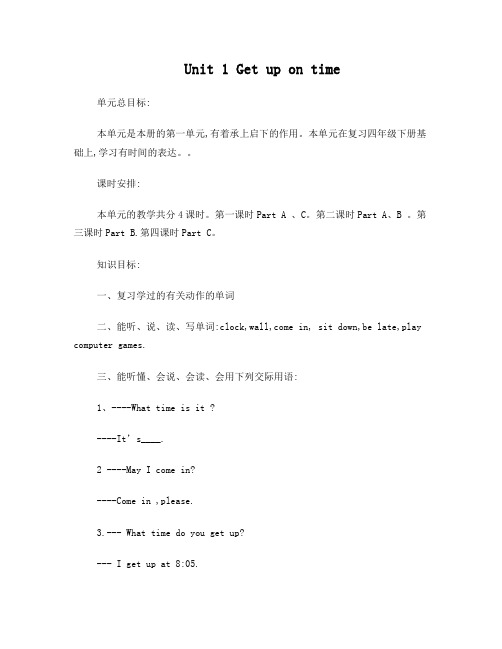
Unit 1 Get up on time单元总目标:本单元是本册的第一单元,有着承上启下的作用。
本单元在复习四年级下册基础上,学习有时间的表达。
课时安排:本单元的教学共分4课时。
第一课时Part A 、C。
第二课时Part A、B 。
第三课时Part B.第四课时Part C。
知识目标:一、复习学过的有关动作的单词二、能听、说、读、写单词:clock,wall,come in, sit down,be late,play computer games.三、能听懂、会说、会读、会用下列交际用语:1、----What time is it ?----It’s____.2 ----May I come in?----Come in ,please.3.--- What time do you get up?--- I get up at 8:05.能力目标:一、能够正确理解、使用本单元所学单词。
二、能够运用所学的词句看图说话,描述正确的时间。
三、能够听懂询问时间的问句并做出正确的回答。
四、能够通过情景交际,培养语言交际能力。
情感目标:在学习和讨论时间话题中帮助学生树立正确的时间观。
第一课时教学内容:Unit 1 第一课时教学目标:1.复习有关动作的的短语2.学习有关单词:clock,wall,come in, sit down,be late,play computer games.3.能根据教师指令灵活运用上述单词。
4.引导学生感知字母i 在单词中的读音。
教学重点难点本单元四会词句教学准备:教师准备单词图片教学过程:一、课程导入引导学生复习以前学过的表示动作的单词,导入新单词的学习二、教授新课1.新课展示Let’s learn.a.学习clock出示钟表的图片,引导学习clock,并边拼读边板书单词clockb.教授单词clock的读音,并将其在四线三格中板书出来。
注意字母c和k 的正确书写。
2.教师继续通过介绍图片引出单词wall,come in, sit down,be late,play computer games.3.教师播放录音,让学生听并跟读Let’s lear n.部分的单词,期间注意纠正学生的错误读音。
五年级英语上册Unit1GetUponTime教案新陕旅版

五年级英语上册Unit 1 Get Up on Time教案(新陕旅版)Unit 1 Get Up on Time!学段:小学年级:五年级学科:英语单元:Unit 1 课型:新授课课题:Unit 1 Get Up on Time!主备学校:安定区新集中心小学主备人:单元总目标:本单元教学共分为四课时。
第一课时以词汇教学为主,主要是对时间的复习并学习有关活动的词汇,“词不离句”是本课时教学要遵循的原则。
第二课时为会话教学,要求学生在学习重点词汇的基础上能够理解和运用对话Wha?It 's... 学习怎样用英语回答。
第三课时以Part B 中的Let 's learn more 为主,让学生拓展学习更多有关时间的表达,理解和运用句型I get up at...表达几点起床。
第四课时在综合复习本单元重难点的基础上,通过练习检测学生的学习效果。
单元知识目标:一、复习单词:gl, go to bed, get up二、能听、说、读、写有关时间的单词:clock, walldown, be late, play computer ga 三、能听懂、会说、会读、会用询问时间的交际用语:-What time do you get up?-I get up at eight fiv2.-Wha?- It 's sevDon 't play too many computer games and go to bed earl 情感目标:1 、通过复习谈论作息时间,培养学生守时的习惯。
2 、在学习和讨论活动话题作息时间中帮助学生树立正确的时间观。
第一课时教学目标:学习“四会” 单词及词组:clock, walldown , be late, play computer games 并用所学单词和句型描述日常活动及其作息时间。
教学重点:能听懂、会写、会读、会说clock, walldown , be late, play computer ga 教学难点:通过学习,能够用英语询问时间。
最新陕旅版六年英语上册教案(完美版)第一单元Unit 1 It's time to play the violin

Part B:let’s play
Ss: Do you ...?
Ss :同桌之间互相做对话
Ss:自己做对话
Homework:
翻译Part B let’s learn more
写本课的单词
重点
能够正确模仿Let’s talk中的对话,做到语音语调自然。
What time is it?
Can I go out to ...
说出所 学的有关的日常活动的短语,这样可以巩固所学的短语,也可以为新课做铺垫。
P art A:warming-up :Fill in the form and talk
T: What time so you usually get up ?
Ss:I get up at seven .what time do you...?
Part B:let’s learn more
S1:I get up at..
(一)自读短文,勾出不认识的单词、短语、句子。
(二)同桌之间互相讨论。探究不懂的内容。
(三)小组合作解决难点.
Ss:..
Ss:..小组内读短文,练习用英语描述一日作息。.
Part A:Warming –up :look and circle
S1:I watch TV every day .
S2:S1watch TV every day .I do my homework every day .
S3:S1watch TV every day . S2 does his /her homework every day .I cook the meal every day .
人教版pep五年级下册英语unit 1 时间的表达

人教版pep五年级下册英语unit 1 时间的表达English:In Unit 1 of the fifth grade book of People's Education Press (PEP) for English, students will learn how to express time in English. They will learn how to tell time using both digital and analog clocks, as well as expressing time using phrases such as "at", "in", and "on". They will also learn how to use prepositions of time such as "before", "after", "during", and "while" to talk about time-related activities. Throughout the unit, students will engage in activities that involve reading, listening, and speaking about time, allowing them to practice and reinforce their understanding of telling time in English.中文翻译:在人教版五年级英语教材的第一单元中,学生将学习如何用英语表达时间。
他们将学会如何使用数字钟和模拟钟来告诉时间,以及使用诸如“在……时候”,“在……的时候”和“在……上”的短语来表达时间。
五年级英语上册Unit1GetUponTime第1课时教学设计陕旅版三起
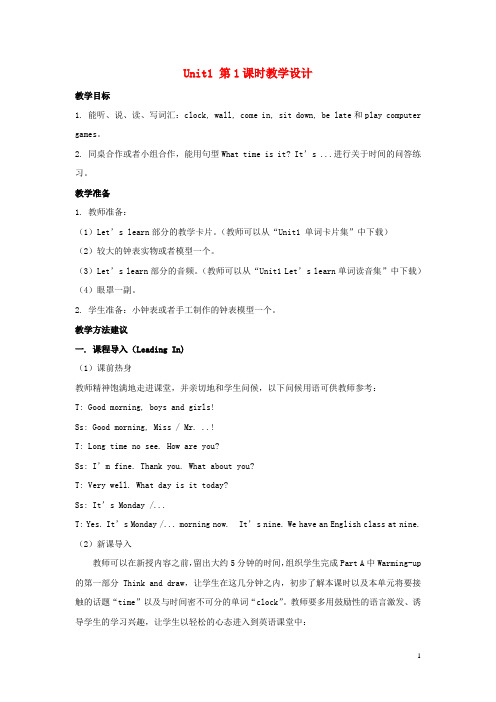
Unit1 第1课时教学设计教学目标1. 能听、说、读、写词汇:clock, wall, come in, sit down, be late和play computer games。
2. 同桌合作或者小组合作,能用句型What time is it? It’s ...进行关于时间的问答练习。
教学准备1. 教师准备:(1)Let’s learn部分的教学卡片。
(教师可以从“Unit1 单词卡片集”中下载)(2)较大的钟表实物或者模型一个。
(3)Let’s learn部分的音频。
(教师可以从“Unit1 Let’s learn单词读音集”中下载)(4)眼罩一副。
2. 学生准备:小钟表或者手工制作的钟表模型一个。
教学方法建议一. 课程导入(Leading In)(1)课前热身教师精神饱满地走进课堂,并亲切地和学生问候,以下问候用语可供教师参考:T: Good morning, boys and girls!Ss: Good morning, Miss / Mr. ..!T: Long time no see. How are you?Ss: I’m fine. Thank you. What about you?T: Very well. What day is it today?Ss: It’s Monday /...T: Yes. It’s Monday /... morning now. It’s nine. We have an English class at nine.(2)新课导入教师可以在新授内容之前,留出大约5分钟的时间,组织学生完成Part A中Warming-up 的第一部分Think and draw,让学生在这几分钟之内,初步了解本课时以及本单元将要接触的话题“time”以及与时间密不可分的单词“clock”。
教师要多用鼓励性的语言激发、诱导学生的学习兴趣,让学生以轻松的心态进入到英语课堂中:Part A Warming-up: Think and draw由于学生是第一次接触这个话题,所以教师可以先进行示范。
M1 Unit 1 We are having a great time

Betty’s mum: Can you send me a postcard too? Betty: Yes. Lingling and I are writing postcard. We’re enjoying the school trip a lot. Anyway, we’re going home now. Bye! Betty’mum: Bye-bye, Betty!
Tapescript
1.Lingling: Who are you talking to, Betty? Betty: I’m calling my mum. I’m telling her about the Great Wall and what we’re doing.
2.Betty: Are you enjoying the Trip, Lingling? Lingling: Yes, I am. I’m shopping for presents and postcards. Betty: Can you buy some postcards for me, please?
Betty: We’re on a school trip and we’re having a good time. Betty’s mun: That’s great, Betty. What are the others doing?
Betty: Hi mum , can you hear me ? Betty's mum: Yes , I can . Where are you ? Betty: I’m standing on the Great Wall of China and talking to you. Betty's mum: Really?
新视野大学英语2Unit1time-consciousamericans
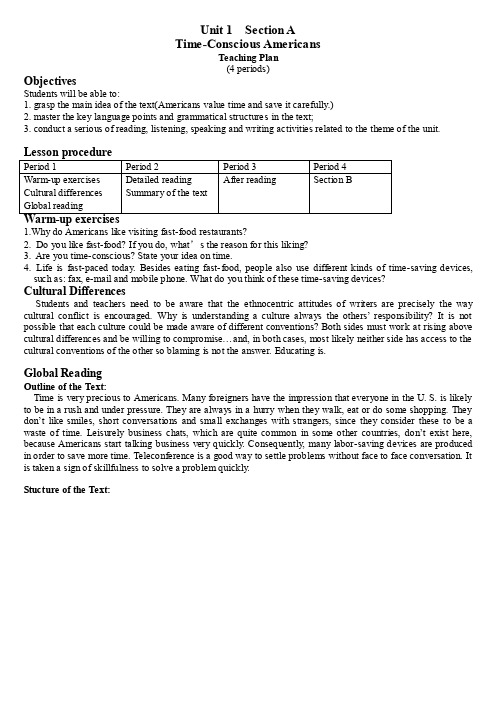
Unit 1 Section ATime-Conscious AmericansTeaching Plan(4 periods)ObjectivesStudents will be able to:1. grasp the main idea of the text(Americans value time and save it carefully.)2. master the key language points and grammatical structures in the text;3. conduct a serious of reading, listening, speaking and writing activities related to the theme of the unit.1.Why do Americans like visiting fast-food restaurants?2. Do you like fast-food? If you do, what’s the reason for this liking?3. Are you time-conscious? State your idea on time.4. Life is fast-paced today. Besides eating fast-food, people also use different kinds of time-saving devices, such as: fax, e-mail and mobile phone. What do you think of these time-saving devices?Cultural DifferencesStudents and teachers need to be aware that the ethnocentric attitudes of writers are precisely the way cultural conflict is encouraged. Why is understanding a culture always the others’ responsibility? It is not possible that each culture could be made aware of different conventions? Both sides must work at rising above cultural differences and be willing to compromise…and, in both cases, most likely neither side has access to the cultural conventions of the other so blaming is not the answer. Educating is.Global ReadingOutline of the Text:Time is very precious to Americans. Many foreigners have the impression that everyone in the U. S. is likely to be in a rush and under pressure. They are always in a hurry when they walk, eat or do some shopping. They don’t like smiles, short conversations and sma ll exchanges with strangers, since they consider these to be a waste of time. Leisurely business chats, which are quite common in some other countries, don’t exist here, because Americans start talking business very quickly. Consequently, many labor-saving devices are produced in order to save more time. Teleconference is a good way to settle problems without face to face conversation. It is taken a sign of skillfulness to solve a problem quickly.Stucture of the Text:Detailed ReadingLanguage studyA. New words and Expressions:1. fall behind:1) become bit by bit further behind2) (with) fail to finish at the proper timeEg. 1) fall behind in science 在科学方面落后fall behind one’s competitors 落后于竞争对手2) fall behind with the rent 拖欠房租The student has been working hard for fear that he should fall behind.这个学生一直很努力, 惟恐落后。
Unit 1 It's time to play the violin 教案

Unit 1 It’s Time to Play the Violin.(The second period)说课稿延安实验小学韩强Good morning, dear teachers! I’m very glad to be here and talk about the lesson, which is from Primary School English Book 7 Unit 1,the second period.I divide my teaching report into four parts.Ⅰ.Teaching materialFirst, let me talk about the teaching material.There are eight units in Book 7.This is the first unit, the second period. The content of my lesson is about some verb phrases. The main language point in this lesson is to grasp the new sentences and use them in the daily life .Through the study of this lesson, the students would know how to talk about the habit with the simple sentences. I think the study of this lesson could help the students with their daily communication and stimulate their interest in English.2. According to the new English curriculum standard and the students’ situation, I make the teaching aims as follows.a .The first is the aim of the knowledge.Enable the students to learn and master the verb phrases, use them fluently and correctly in life.b. The second is the aim of abilities.To improve the students’ comprehensive abilities is quite important, so in my class, I paid much attention to cultivate it. Otherwise, I tried to foster the students’ listen ing, speaking, reading and writing abilities. The main task is to improve their abilities of using English and encourage them to speak more English.c. The third is the emotional aim.It’s to make the students gain a sense of achievement and make them have a good habit.3.The key points of this period are how to learn and master the sentences,it’s time to….,can I…?,of course,you can./I’m afraid I can’t.4.Difficult points.They are the usage of the verb phrases and the fluent and free use of the key sentences.Ⅱ. Teaching and learning methods.According to the elementary students’ physiological and psychological characteristics,such as keeping active,good at imitating and showing, I made the students take part in in class,had them talk in pairs and groups. I used communicative method,TPR teaching method and situational teaching method to teach this lesson. And in this class, atape ,tape recorder PPT and a clock have been used.These could arouse the students’ interest in English and help them learn more easily.Ⅲ. Now let’s move on the most important part, teaching procedure. It consists of five steps, warming up and leading in,presentation,practice,summary and homework.StepⅠWarming up and leading in.1.GreetingsIn order to attract the students’attention and cu ltivate an atmosphere of learning English,firstly, I had a friendly greeting with the students. It also promoted the relationship between the students and the teacher.2.Revision .Secondly I asked the students to watch and say, at the same time,the knowledge they have learned has been reviewed.Let the students have a smooth transition from the received knowledge into new knowledge.StepⅡPresentation.The key points of this period are some verb phrases and the sentence patterns,so I showed some time to them , helped them to connect their habits with some body language. Then asked them to use the phrases in some dialogues.And helped them to look at the pictures,listen to the tape and get the answers to the questions.StepⅢPractice1.I asked the students to read the dialogue in pairs .2.Then the students practiced the new sentences by making up new dialogues in pairs.In this way,the stud ents’ interest of learning English has been improved.3.I asked the students to go on talking about their Sunday . They could practice the sentences and improve their abilities of imagination and using English.StepⅣSummaryMaking a summary after each lesson is quite necessary,it can help the students storage the knowledge of this lesson.So I let the students end this class with the key sentences.StepⅤHomeworkIn order to help them master the key points,I asked the students to make a time table for their weekends,and talk with their friends.I think it can consolidate the knowledge they have learned and have them use more English in daily life.Ⅳ.Blackboard designIn the middle of the blackboard,I wrote down the key sentences. It can help them learn clearly and easily.That’s all for my teaching report.Thanks for your attention.。
6年级英语第一单元story time翻译

6年级英语第一单元story time翻译
故事时间
在阳光明媚的一天,一只名叫汤姆的猫在公园里散步。
他看到一只鸟儿在天空中飞翔。
"我也想飞!" 汤姆想。
他看到一只狗在快乐地跑跳。
"我也想跑和跳!" 汤姆想。
然后,他看到一只小老鼠在草丛中玩耍。
"我也想玩!" 汤姆想。
"我真的很羡慕你们!" 汤姆对其他动物说。
"我也想做你们做的事情!"
"没问题!" 小老鼠说。
"我可以帮你跑和跳。
小鸟,你可以教他飞。
小狗,你可以教他追球。
" 然后,他们开始训练汤姆。
小老鼠教他如何跑和跳。
小鸟教他如何飞。
小狗教他如何追球。
"太棒了!" 汤姆说。
"我真的很感谢你们!"
"不用客气!" 其他动物说。
"我们都很乐意帮助你。
"
他们一起玩了很长时间,然后一起回家了。
Unit 1 Free time

Unit 1 Free timeIn Unit 1 we will review.how to talk about likes and dislikes.how to introduce yourself.how to exchange personal information.hobbies and leisure activities.frequency adverbs.how to talk about routines and habits.how to talk about past experiencesLesson 1 I like playing the guitar.(两课时)(第一课时)一、教学目标1.知识目标:巩固如何表达对事物的喜欢和不喜欢,交流个人信息。
2.能力目标:能听懂对过去发生的事情和将要做的事情的描述,以及对某喜欢做什么、不喜欢做什么的描述。
二、教学内容1.词汇Province, hobby, married, single, strict, violin, piano, guitar, model, collect, coin, stamp, chat, download, poster, form2.句型(1)I like playing the quitar, but I prefer playing football.(2) Which club would you like to join?I’d like to join the Music Club because I like playing the guitar.三、教学重点1.掌握课标词汇2.练熟重点句型四、教学步骤Section 1.Look, listen and sayStep 1. Lead-in经过一个较长的假期后,可以和学生谈论他们的假期活动来复习过去时态:T:I believe many of you traveled during the summer holidays. How many of you did that? Hands up. Please.Oh, there are so many.(choose on student)Could you please tell me where you went?Who went there with you?How did you go there? By train or by air?Did you see something interesting there? Or did you see some interesting people there?Step 2. Listening and writing1.教师放一遍录音,要求学生说出录音中说了什么?(中英文均可)2.教师放第二和第三遍录音,控制速度让学生填写。
大学英语Unit 1 Time Management

Words and Expressions
try out: test or use (sb./sth.) in order to see how good or effective they are 试用 I like this soap. You may try it out, too. 我喜欢这种肥皂。你不妨也试试。 We talked to some American visitors in the park to try out our English. 我们同公园里的美国来访者交谈,以试一下 我们的英语.
letter真题范例请以sam的名义给他的朋友david写一封感谢信感谢david邀请他参加生日派对并谈及他对david家人的感受
Unit One Time Management
Focus
Time-Out!
Lead–in Activities Words & Expressions
Text Understanding Writing
Words and Expressions
work on: try hard to improve or achieve (sth.) 努力改善;努力完成 You need to work on your pronunciation a bit more. 你需要稍加努力来改善你的发音。 John has been working on an English textbook with Prof. Lee. 约翰一直在和李教授一起编写一本英语教材。
Words and Expressions
depend 视…而定,取决(于);依靠(on,
upon) The cooking time depends on the size of the potato. 烹调时间要看土豆的大小而定。 He depended on his writing for his income. 他依靠写作取得收入。
unit 1 time-conscious Americans 美国人的时间观念

• She went through her usual ______ of • Making sure all the doors were locked • Before she went to bed.
• Defy ______ by wearing outrageous clothes.
• Interaction: • inter 前缀,表示在…之间,相互。 • Eg. Inter+national • inter+personal • The interaction of these two groups produced many good ideas.
In the U.S., people tend to be 5’~10’ late (B) _____________.
In China, before 7:00 (A) , close friends tend to arrive _______________ but acquaintances tend to arrive 5’~10’ earlier (D) _______________.
restless
• We grow restless with the long wait.
•Elbow: 用肘推人
• He elbowed me out of the way. • 他把我挤开了。 • She elbowed her way through the crowd towards the theater. • 她用肘推着从人群中走向剧院。
Assess: 如何记忆? a (Asia)+ss( 美女)+ e(Europe)+ss(美女) 人们评价亚洲的美女比欧洲美女要漂亮。
高中英语必修二unit1videotime文本
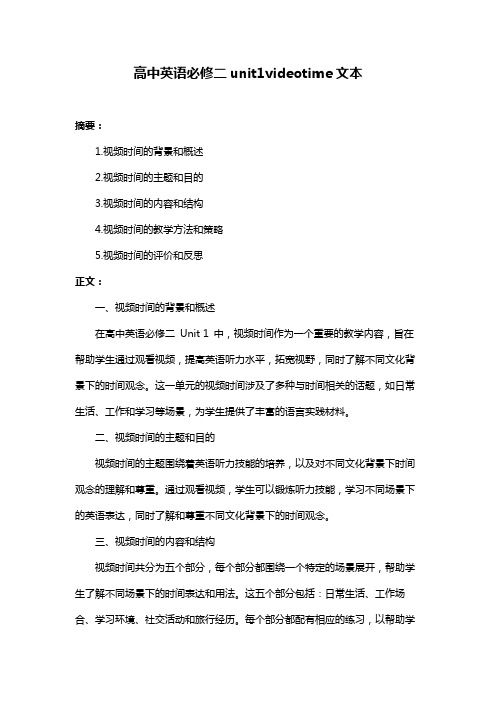
高中英语必修二unit1videotime文本摘要:1.视频时间的背景和概述2.视频时间的主题和目的3.视频时间的内容和结构4.视频时间的教学方法和策略5.视频时间的评价和反思正文:一、视频时间的背景和概述在高中英语必修二Unit 1 中,视频时间作为一个重要的教学内容,旨在帮助学生通过观看视频,提高英语听力水平,拓宽视野,同时了解不同文化背景下的时间观念。
这一单元的视频时间涉及了多种与时间相关的话题,如日常生活、工作和学习等场景,为学生提供了丰富的语言实践材料。
二、视频时间的主题和目的视频时间的主题围绕着英语听力技能的培养,以及对不同文化背景下时间观念的理解和尊重。
通过观看视频,学生可以锻炼听力技能,学习不同场景下的英语表达,同时了解和尊重不同文化背景下的时间观念。
三、视频时间的内容和结构视频时间共分为五个部分,每个部分都围绕一个特定的场景展开,帮助学生了解不同场景下的时间表达和用法。
这五个部分包括:日常生活、工作场合、学习环境、社交活动和旅行经历。
每个部分都配有相应的练习,以帮助学生巩固所学知识。
四、视频时间的教学方法和策略在教学视频时间时,教师可以采用以下方法和策略:1.提前预习:教师可以提前为学生提供视频材料,让学生在家中预习,这样学生在课堂上就能更专注于练习和讨论。
2.课堂讨论:在课堂上,教师可以组织学生分组讨论,分享他们在视频中看到的有趣细节和学到的新知识。
3.角色扮演:教师可以引导学生进行角色扮演,模拟视频中的场景,让学生在实际情境中运用所学知识。
4.制作时间表:教师可以引导学生根据视频内容制作时间表,以巩固所学知识,并提高学生的时间管理能力。
五、视频时间的评价和反思教师可以采用多种方式对学生的学习成果进行评价,如作业评分、课堂表现和期末考试等。
同时,教师应鼓励学生进行自我反思,思考自己在学习过程中的优点和不足,并提出改进措施。
总之,高中英语必修二Unit 1 的视频时间是一个富有挑战性和趣味性的教学内容。
外研剑桥版英语四年级下册Unit 1 Time 教案
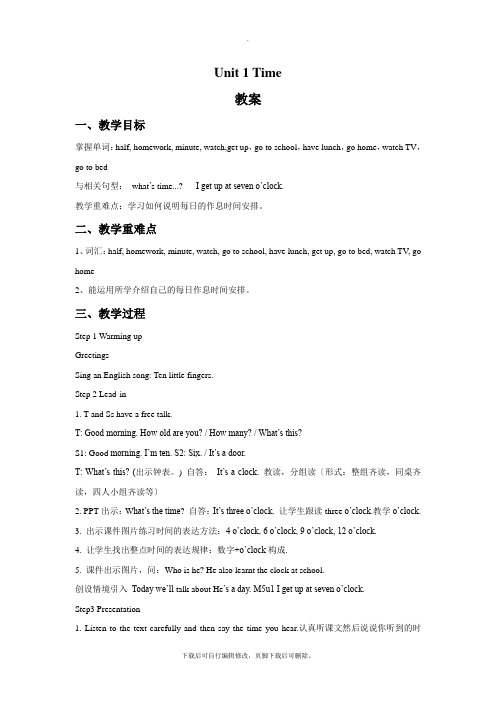
Unit 1 Time教案一、教学目标掌握单词:half, homework, minute, watch,get up,go to school,have lunch,go home,watch TV,go to bed与相关句型:what’s time...? I get up at seven o’clock.教学重难点:学习如何说明每日的作息时间安排。
二、教学重难点1、词汇:half, homework, minute, watch, go to school, have lunch, get up, go to bed, watch TV, go home2、能运用所学介绍自己的每日作息时间安排。
三、教学过程Step 1 Warming upGreetingsSing an English song: Ten little fingers.Step 2 Lead-in1. T and Ss have a free talk.T: Good morning. How old are you? / How many? / What’s this?S1: Good morning. I’m ten. S2: Six. / It’s a door.T: What’s this? (出示钟表。
) 自答:It’s a clock. 教读,分组读〔形式:整组齐读,同桌齐读,四人小组齐读等〕2. PPT出示:W hat’s the time? 自答:It’s three o’clock. 让学生跟读three o’clock.教学o’clock.3. 出示课件图片练习时间的表达方法:4 o’clock, 6 o’clock,9 o’clock, 12 o’clock.4. 让学生找出整点时间的表达规律:数字+o’clock构成.5. 课件出示图片,问:Who is he? He also learnt the clock at school.创设情境引入Today we’ll talk about He’s a day. M5u1 I get up at seven o’clock.Step3 Presentation1. Listen to the text carefully and then say the time you hear.认真听课文然后说说你听到的时间。
Unit 1 同步练习(5)
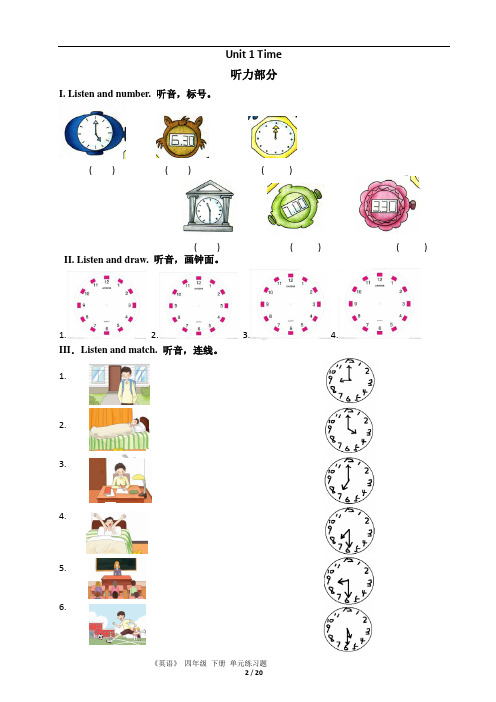
Unit 1 Time听力部分I. Listen and number. 听音,标号。
( ) ( ) ( )听音,画钟面。
1. 2. 3. 4.III Listen and match. 听音,连线。
1.2.3.4.5.6.IV.Listen and choose. 听问句,选答句。
()1. A. It’s five o’clock. B. It’s in July.()2. A. Yes, there are. B. There are 7. ()3. A. At seven. B. I get up.()4. A. There are twelve. B. There are four.V.((()3. A. I do sport at four.B. I do my homework at four.( )4. A. I get up at half past eight. B. I go to bed at half past eight.II. Read and choose .选择填空。
( ) 1. _____ time is it?(III (IV . Look, read and write.V. Reading.A. Read and choose. 读短文,选择正确的答案。
There are two clocks in Rita’s room. It is half past four by the red clock on the bed. It is five o’clock by the green clock in the box.Rita has got two watches, too. One is under the table, the other is on the chair. It is four o’clock on the watch under the table. It is half past four on the watch on the chair.((((( ) 5. Sue and May like playing table tennis.。
- 1、下载文档前请自行甄别文档内容的完整性,平台不提供额外的编辑、内容补充、找答案等附加服务。
- 2、"仅部分预览"的文档,不可在线预览部分如存在完整性等问题,可反馈申请退款(可完整预览的文档不适用该条件!)。
- 3、如文档侵犯您的权益,请联系客服反馈,我们会尽快为您处理(人工客服工作时间:9:00-18:30)。
What’s the time ?
It’s seven o’clock.
It’s half past seven.
课后反思:
介休市中小学教案第1页
续页
教学过程设计年月日
教师活动预设
预设学生行为及设计理念
补充修订
一、热身/复习(Warm-up/Revision)
师出示一个谜语,让学生猜。
教学
重点
In this class, the pupils learn to use: What’s the time?
It’s (seven) o’clock. / It’s half past (seven).
教学
难点
How to express the time
板书设计:
Unit 5 Time
章节首页
教学过程设计年月日
章节
课题
Unit 3 Time
课时
1
主备
教师
参与备
课教师
授课
教师
课型
新授
三维教学目标
知识技能
1:The pupils can master the hour and half past the hour.
2:学会单词o’clock \ half \ past
3:学会运用句型What time is it ?以及What’s the time?
询问时间(整点和半点)
过程方法
通过运用多媒体课件和钟表模具来进行新课教学,然后通过游戏以及画时间来巩固时间的表达法,最后通过小组合作的方式来训练英语时间的问答。并且课前要求学生自制钟面一个,课堂上利用自己制作的钟面开展多种活动,培养学生惜时如金的观念。
价值观
情感态度
通过对钟表时间的认识,教育学生珍惜时间,热爱生命,好好学习。培养学生的时间观念,激发学生的学习兴趣,培养学生反应能力,创新能力和合作意识.
学生间互相练习说整点时间的表达法
(方法同上)
让学生知道世界各地之间有时间差,以拓宽学生的知识面
3本课核心的教学项目是“Asking about time(询问时间)”,各种对话、问答、朗读、表演材料都围绕这一功能意念展开。
介休市中小学教案第3页
续页
教师活动预设
预设学生行为及设计理念
补充修订
4、任务型操练:
3.The pupils learn to say: What’s the time? / It’s seven o’clock.
A riddle:
We can’t see .
We can’t touch .
It runs all day and all night.
It never(从不)stops.
所用材料:钟表模具
活动成员:全班
活动形式;把全班同学分成若干四人小组
操作过程:
四人一组进行比赛,一名学生说出一个时间,其余三名学生比比谁拼得最快最准。
(望同学们积极参与,大胆开口,很好合作,展示才华)
六、拓展性活动(Add-activities)
老师在讲台上说一个句子:
如:It’s half past six.
5.教师、个别学生间对整点时间进行问答;教师要求学生用自己的动作模仿他通常在这个时间里活动,并给予相应鼓励。
半点钟( half past )
(方法同上)
6.教师利用自己的动作,要求学生猜猜看:What’s the time?
引出新授内容:It’s half past ten.
综合操练(Practice)
学生先把教材上的时间读一读,然后教师放第一部分录音,学生仔细听(不要着急写)第二次对照时间模仿着说,第三次拿出笔写答案,之后,师生一起订正答案。五、趣味操练ຫໍສະໝຸດ Practice)时间游戏:
“强说时间比赛:”
活动目的:激发学生主动参与学习的热情,提高学生的听力,朗读和
口语表达能力,并让学生能根据已有的信息进行分析和判断的能力。
课件展示
二、呈现新课(Presentation)
课件展示
整点钟(o’clock)
1.教师拿出自制钟面,拨到七点,走到多个同学面前,说:Good morning.
学生拿出自制钟面,拨到七点,回答老师:Good morning。
2.教师将七点钟面贴到黑板上,问:What’s the time?
并自答:It’s seven o’clock.
7.同位之间操练句型:What’s the time?
It’sseveno’clock.//It’s half pastseven.
(利用自己手中的钟面,任意改变整点和半点时间,互问互答,同时用动作模仿当时自己的活动。)
8.听声音,猜时间。
以小组为单位,竞猜。
三、Good to know
教师出示世界地图,让学生知道北京和纽约的时间差为13个小时,我们正午12时,也正好是纽约午夜12时
口语表达能力,并让学生能根据已有的信息进行分析和判断的能力。
教学过程设计年月日
介休市中小学教案第4页
续页
教师活动预设
预设学生行为及设计理念
补充修订
语篇教学
情感渗透:
Arrange your daily life properly , it well help you
It makes us older and older.
学生配合教师学说整点时间的表达法
1:教师指着钟表问学生:What’s the time?或What time is it?让学分别读出每个时间,同时教学整点钟的读法(o’clock)。待学生熟练掌握此种时间表达法后,再用自制的简易钟表,教学用past表达时间的方法,教师先指着钟表说:It’s eight thirty.. It’s half past eight.把它写在黑板上,待学生读熟后,拔到不同的时间,让学生反复练习,最后教给学生顺口溜,加强记忆。
2:教师利用课件来展示新课学生会有新鲜感
以此来激发学生的学习兴趣
介休市中小学教案第2页
续页
教学过程设计年月日
教师活动预设
预设学生行为及设计理念
补充修订
4.同位、小组之间互相练习:What’s the time? / It’s seven o’clock.
(并利用自己手中的钟面,任意改变整点时间,互问互答。)
It’s time toget up.
1:学生边听边观察
2:学生边听边模仿说
3:学生边听边写答案
4:互相矫正答案
学生比比看谁说的快,谁说得准,谁得分最多
学生观看课件图片,仿说句子。
It’s.
It’s time to.
4:鼓励学生说
要求反应迅速,回答正确。
激5:激发学生主动参与学习的热情,提高学生的听力,朗读和
